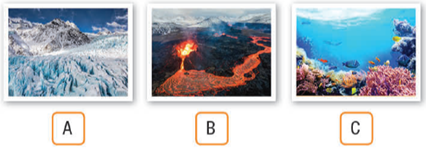b. Now, listen and circle.
(Bây giờ, hãy nghe và khoanh.)
1. How many solutions does Terry say he is going to give?
a. one b. two c. three
2. What does Terry say is removed by deforestation?
a. animal habitats b. oxygen c. food
3. What is the second problem he talks about?
a. cost of relocating animals b. increase of CO2 levels c. closing of companies
4. What is the first solution he talks about?
a. planting replacement trees b. cutting down fewer trees c. relocating animals
5. Where can people ask him questions?
a. online b. in the hall c. on the phone

1. Terry nói rằng anh ấy sẽ đưa ra bao nhiêu giải pháp?
a. một
b. hai
c. ba
Thông tin: I will tell you about two simple things that can be done to improve the situation.
(Tôi sẽ nói về hai điều đơn giản có thể được thực hiện để cải thiện tình hình.)
Đáp án: b
2. Terry nói cái gì bị mất do phá rừng?
a. môi trường sống của động vật
b. oxy
c. đồ ăn
Thông tin: The first main problem caused by deforestation is that it is removing the habitats of animals.
(Vấn đề chính đầu tiên do nạn phá rừng gây ra là nó đang lấy đi môi trường sống của động vật.)
Đáp án: a
3. Vấn đề thứ hai mà anh ấy nói đến là gì?
a. chi phí di dời động vật
b. tăng nồng độ CO2
c. đóng cửa các công ty
Thông tin: The second problem I want to highlight is the increased amount of CO2 in the air.
(Vấn đề thứ hai tôi muốn nhấn mạnh là lượng CO2 trong không khí tăng lên.)
Đáp án: b
4. Giải pháp đầu tiên anh ấy nói đến là gì?
a. trồng cây thay thế
b. chặt ít cây hơn
c. di dời động vật
Thông tin: Firstly, before trees are cut down, the animals that live there must be relocated.
(Thứ nhất, trước khi chặt cây, các loài động vật sống ở đó phải được di dời.)
Đáp án: c
5. Mọi người có thể đặt câu hỏi cho anh ấy ở đâu?
a. trực tuyến
b. trong hội trường
c. trên điện thoại
Thông tin: If anyone has any questions, please come and speak to me in the hall. Thank you.
(Nếu ai có bất kỳ câu hỏi nào, xin vui lòng đến và nói chuyện với tôi trong hội trường. Cảm ơn.)
Đáp án: b

Các bài tập cùng chuyên đề
Human impact on ecosystems
(Ảnh hưởng của con người lên hệ sinh thái)
1. Choose the correct meanings of the word and phrases.
(Chọn nghĩa đúng của từ và cụm từ.)
1. coral reef (rạn san hô)
A. a plant that grows in the sea
(một loại cây mọc ở biển)
B. a line of hard rock formed by coral found in warm sea water
(một dòng đá cứng được hình thành bởi san hô được tìm thấy trong nước biển ấm)
2. food chain (chuỗi thức ăn)
A. the order in which living things depend on each other for food
(thứ tự các sinh vật phụ thuộc vào nhau để kiếm thức ăn)
B. the order in which food is provided
(thứ tự cung cấp thực phẩm)
3. run out (cạn kiệt)
A. to use all of something
(để sử dụng tất cả của một cái gì đó)
B. to experience something unexpectedly
(để trải nghiệm một cái gì đó bất ngờ)
4. break down (phá vỡ)
A. to make smaller (nhỏ lại)
B. to stop working (ngừng hoạt động)
2. Listen to a talk and choose the correct answers A, B, or C.
(Nghe bài nói chuyện và chọn câu trả lời đúng A, B hoặc C.)
1. Why is Dr Logan invited to give a talk?
(Tại sao Tiến sĩ Logan được mời nói chuyện?)
A. Because he knows Nam.
(Bởi vì anh ấy biết Nam.)
B. Because he’s an expert in biodiversity conservation.
(Bởi vì anh ấy là một chuyên gia về bảo tồn đa dạng sinh học.)
C. Because he’s a member of the environment club.
(Bởi vì anh ấy là thành viên của câu lạc bộ môi trường.)
2. Which of the benefits provided by a healthy ecosystem is NOT mentioned?
(Lợi ích nào do một hệ sinh thái lành mạnh mang lại KHÔNG được đề cập?)
A. Cleaning our air and water.
(Làm sạch không khí và nước của chúng ta.)
B. Controlling climate changes.
(Kiểm soát biến đổi khí hậu.)
C. Recycling waste naturally.
(Tái chế chất thải một cách tự nhiên.)
3. How much of the coral reefs has disappeared?
(Bao nhiêu rạn san hô đã biến mất?)
A. 25%.
B. 50%.
C. 90%.
4. What may happen as a result of damaging the ecosystem balance?
(Điều gì có thể xảy ra khi làm tổn hại đến sự cân bằng của hệ sinh thái?)
A. More space for farming and houses.
(Thêm không gian cho canh tác và nhà cửa.)
B. Lack of food, water, and fresh air.
(Thiếu thức ăn, nước uống và không khí trong lành.)
C. Fewer natural disasters.
(Ít thiên tai hơn.)
5. What do you think Dr Logan will talk about next?
(Bạn nghĩ Tiến sĩ Logan sẽ nói về điều gì tiếp theo?)
A. Ways to repair damaged ecosystems.
(Các cách để sửa chữa các hệ sinh thái bị hư hại.)
B. Ways to restore the food chain
(Các cách khôi phục chuỗi thức ăn.)
C. The future of human life.
(Tương lai của cuộc sống con người.)
3. Listen again and decide whether the statements are true (T) or false (F).
(Nghe lại và quyết định xem các câu đúng (T) hay sai (F).)
|
|
T |
F |
|
1. The threat to the earth’s biodiversity comes from human activities. (Mối đe dọa đối với đa dạng sinh học của trái đất đến từ các hoạt động của con người.) |
|
|
|
2. Nearly half of the world’s forests have been cut down. (Gần một nửa diện tích rừng trên thế giới đã bị đốn hạ.) |
|
|
|
3. The disappearance of some species may cause problems to the food chain. (Sự biến mất của một số loài có thể gây ra vấn đề cho chuỗi thức ăn.) |
|
|
|
4. The health of human beings does not depend on a healthy ecosystem. (Sức khỏe của con người không phụ thuộc vào một hệ sinh thái lành mạnh.) |
|
|
4 Listen to a talk on the course of the Mekong River. Arrange the places along the course of the Mekong River in the order of listening.
(Nghe một bài nói chuyện sông Mekong. Sắp xếp các địa điểm dọc theo dòng sông Mekong theo thứ tự nghe.)
A Golden Triangle
(Tam giác Vàng)
B Tibetan Plateau
(Cao nguyên Tây Tạng)
C The tripoint of Myanmar, China and Laos
(Tam điểm Mianma, Trung Quốc, Lào)
D The Cuu Long River
(Sông Cửu Long)
E The Three Parallel Rivers Area
(Tam Giang Tịnh Lưu)
5. Listen again and decide whether the following statements are true (T) or false (F).
(Nghe lại và quyết định xem những câu sau đây là đúng (T) hay sai (F).)
1. The Mekong River has most of its drainage area in Laos and Thailand.
(Sông Cửu Long có phần lớn diện tích thoát nước ở Lào và Thái Lan.)
2. The Mekong River is to the west of the Salween River.
(Sông Cửu Long nằm ở phía tây của sông Salween.)
3. The Golden Triangle is referred to as the second tripoint the Mekong River runs through.
(Tam giác vàng được gọi là ngã ba thứ hai mà sông Mekong chảy qua.)
4. The Mekong River runs through Laos for over 1,000 kilometres before entering Cambodia.
(Sông Cửu Long chảy qua Lào hơn 1.000 km trước khi vào Campuchia.)
a. Listen to two students talking about foreign species. How does Steven feel about them?
(Nghe hai sinh viên nói về các loài ngoại lai. Steven cảm thấy thế nào về chúng?)
1. interested (quan tâm)
2. worried (lo lắng)
b. Now, listen and circle True or False.
(Bây giờ, hãy lắng nghe và khoanh tròn Đúng hoặc Sai.)
1. Steven is studying foreign species in science class.
(Steven đang nghiên cứu các loài ngoại lai trong lớp khoa học.)
2. Humans have brought foreign species around the world for hundreds of years.
(Con người đã mang các loài ngoại lai đi khắp thế giới hàng trăm năm.)
3. The Burmese pythons in Florida have eaten some native species.
(Những con trăn Miến Điện ở Florida đã ăn thịt một số loài bản địa.)
4. Two men caught a Burmese python that was nine meters long.
(Hai người đàn ông bắt được con trăn Miến Điện dài 9 mét.)
5. Steven feels bad that some foreign species must be killed.
(Steven cảm thấy tồi tệ khi phải giết một số loài ngoại lai.)
a. Listen to the news report about illegal wildlife trade.Where did the problem happen?
(Nghe bản tin về nạn buôn bán động vật hoang dã bất hợp pháp. Vấn đề xảy ra ở đâu?)
1. in the jungle (trong rừng)
2. in the city (trong thành phố)
3. in the countryside (ở nông thôn)
b. Now, listen and write True or False.
(Bây giờ, hãy nghe và viết Đúng hoặc Sai.)
1. The police heard strange noises coming fro a house.
(Cảnh sát nghe thấy tiếng động lạ phát ra từ một ngôi nhà.)
2. The people were keeping baby turtles and tigers in the house.
(Mọi người đang nuôi rùa con và hổ trong nhà.)
3. The animals were caught in another country.
(Động vật bị bắt ở nước khác.)
4. One neighbor said he was very sad to learn about illegal wildlife trade in the city.
(Một người hàng xóm nói rằng anh ấy rất buồn khi biết tin về buôn bán trái phép động vật hoang dã tại thành phố.)
5. The police found 50 animals in the house.
(Cảnh sát tìm thấy 50 con vật trong nhà.)
4. Listen and match the speakers (A-C) to the ecosystems (1-6) in Exercise 1. What ecosystems are they talking about?
(Nghe và nối những người nói (A-C) với các hệ sinh thái (1-6) trong Bài tập 1. Họ đang nói về những hệ sinh thái nào?)
Speaker A _____
Speaker B _____
Speaker C _____
3. You are going to listen to a lecture about ecosystems. Read the questions and answer choices. Which of the answer choices do you think will be the right ones?
(Bạn sẽ nghe một bài giảng về hệ sinh thái. Đọc câu hỏi và trả lời các lựa chọn. Những lựa chọn trả lời nào bạn nghĩ sẽ là những lựa chọn đúng?)
1. What is Dr Cord's research about?
A. how scientists study the damage to ecosystems
B. how to repair the damage to ecosystems
C. the effects of human activities on ecosystems
D. how ecosystems are homes for life on Earth
2. Which activity does Dr Cord think is an easy solution to the environment problems?
A. planting more trees in the forests
B. cleaning up plastic in the oceans
C. building more farmlands
D. repairing ponds and rivers
3. What does Dr Cord believe is the best way to protect ecosystems?
A. a clean-up project
B. a global effort
C. a change in individual habits
D. a farmland protection plan
4. Now listen to the lecture. For questions (1-3), choose the best answer (A, B, C or D).
(Bây giờ nghe phần bài giảng. Đối với câu hỏi (1-3), chọn câu trả lời đúng nhất (A, B, C hoặc D).)
3. Listen to an interview about a project for an eco-school. Which features from Exercise 2 are mentioned?
(Nghe một cuộc phỏng vấn về một dự án cho một trường học sinh thái. Những đặc điểm nào từ Bài tập 2 được đề cập?)
4. Listen again and choose the correct answer, A, B or C.
(Nghe lại và chọn câu trả lời đúng A, B hoặc C.)
1. 'Friends of the Planet' is an after-school club with members from
('Những người bạn của hành tinh' là một câu lạc bộ sau giờ học với các thành viên từ)
A. one school. (một trường.)
B. seven schools. (bảy trường.)
C. six schools. (sáu trường.)
2. The aim's project is
(Mục đích của dự án là)
A. to make environmentally-friendly changes tonschools.
(để thực hiện những thay đổi thân thiện với môi trường trong trường học.)
B. to create a new type of solar panel for schools.
(để tạo ra một loại tấm pin năng lượng mặt trời mới cho các trường học.)
C. to help design a new environmentally-friendly school.
(để giúp thiết kế một ngôi trường mới thân thiện với môi trường.)
3. School dinners will include vegetables from
(Bữa tối ở trường sẽ bao gồm các loại rau từ)
A. a local farm.
(một trang trại địa phương.)
B. the local supermarket.
(siêu thị địa phương.)
C. the school garden.
(vườn trường.)
4. Science and technology lessons will
(Bài học khoa học và công nghệ sẽ)
A. be the same as in other secondary schools.
(giống như ở các trường trung học cơ sở khác.)
B. not focus on climate change.
(không chú trọng đến biến đổi khí hậu.)
C. concentrate a lot on environmental issues.
(tập trung nhiều vào vấn đề môi trường.)
5. The interviewer comments that
(Người phỏng vấn nhận xét rằng)
A. Michael is probably not a typical teenager.
(Michael có lẽ không phải là một thiếu niên điển hình.)
B. Michael is like every other student of his age.
(Michael giống như mọi học sinh khác ở độ tuổi của anh ấy.)
C. Michael likes games and gadgets.
(Michael thích trò chơi và phụ tùng.)
2. Listen to a teacher and two students discussing the three logos. Which logo do they choose and why?
(Lắng nghe một giáo viên và hai học sinh thảo luận về ba logo. Họ chọn logo nào và tại sao?)
3. Listen again and complete the conversation with one word in each gap. Then listen again and check.
(Nghe lại và hoàn thành đoạn hội thoại với một từ trong mỗi chỗ trống. Sau đó nghe lại và kiểm tra.)
T = Teacher (giáo viên)
B = Boy (học sinh nam)
G = Girl (học sinh nữ)
T: So, what do you think of these three designs?
B: Personally, I think they're all great. The three logos focus 1______ the environment.
Logos 2 and 3 are attractive and amusing. But I think the best option would be logo number 1 2______it has a serious message about learning.
G: I agree, but the 3______ with logo number 1 is that it doesn't mention eco-school. Logo number 2 looks attractive, but it doesn't 4______ school or learning. So choose number 3 because it's clever and simple.
B: Personally, I wouldn't 6______ for number 3. I'd definitely 7______logo number 1 because it’s ______ effective 9______ the other two, and the message is clear. The words suggest that we are responsible for the future of the planet.
T: 10______ of these three logos, I'd choose logo number 3. I 11______ choose the logo 12______, because the glasses suggest learning and 13______, because I think we need the words eco-school in the logo. So let's go for number 3. I'll call the designer.
1. Two friends are talking about a school event. Listen and decide if each of the statements (1-5) is T (True) or F (False).
(Hai người bạn đang nói về một sự kiện ở trường. Nghe và quyết định xem mỗi câu (1-5) là T (Đúng) hay F (Sai).)
1 The speakers have organised the event themselves. ________
2 The event will raise money to plant new trees after wildfires and landslides. ________
3 We need plant life to help to repair the flood damage. ________
4 People will be able to buy things at the event. ________
5 The guest speaker will talk about their work. ________
2. Listen to a lecture about forest fires in Australia. For questions (1-4), choose the best answer (A, B, C or D).
(Nghe bài giảng về cháy rừng ở Australia. Đối với câu hỏi (1-4), chọn câu trả lời đúng nhất (A, B, C hoặc D).)
1 What was different about the forest fire in Australia in 2019-2020?
A It happened at a different time of year than usual.
B It was the first forest fire for some time.
C It caused more damage than any other forest fire.
D It burned longer than any other fire before.
2 How many people died in the fire?
A 34
B 240
C 1.5 billion
D 57
3 What was the final factor that caused the wildfire in January 2020?
A high temperatures
B low rainfall
C dry weather
D strong winds
4 What did scientists find in 2020?
A Why Australia gets more forest fires than other countries.
B What caused the 2019-2020 fire in Australia.
C How climate change is affecting forest fires.
D How the temperature has changed in Australia since 1910.
Phương pháp
Bài nghe
Forest fires have always occurred in Australia. High temperatures and low rainfall from September to March creates the perfect conditions for fires to start and spread. However, the 2019 to 2020 fire season was much worse than it has ever been before. The fires began in July 2019 and burned for 240 days. At least 34 people and about 1.5 billion animals died. The flames and the smoke had a direct impact on 57% of the population of Australia. 2019 was the hottest and driest in Australia since records began in 1910. When temperatures are high, then trees, grass and other plants are very dry, so fires will start more easily. Also, strong winds reaching 130 kilometers per hour can cause fast moving wildfires. How did the fires happen? In 2020, a team of 18 experts from six countries carried out an investigation. They found that climate change increased the risk of forest fires in Australia in 2019 to 2020 by at least 30%. Unless we do something about climate change soon, major forest fires will continue to happen, and not just in Australia. Similar fires occurred in the USA, Russia and the Amazon in 2019 and 2020. Climate change is a global problem, and we must do whatever we can to slow it down. By going green, we can make small changes that can make a big difference for the future of our planet.
a. Listen to Ben and Anna talking about the Northern Pacific sea star. Is the sea star still a problem in Australia?
(Hãy nghe Ben và Anna nói về sao biển Bắc Thái Bình Dương. Có phải sao biển vẫn là một vấn đề ở Úc?)
1. yes
2. no
b. Now, listen and answer.
(Bây giờ, hãy nghe và trả lời câu hỏi.)
1. What is Ben’s book about?
(Cuốn sách của Ben nói về cái gì?)
2. How did Northern Pacific sea stars travel to Australia?
(Những con sao biển Bắc Thái Bình Dương đã đến Úc như thế nào?)
3. How long did it take for the Northern Pacific sea star population to reach 12 million in one area?
(Mất bao lâu để quần thể sao biển Bắc Thái Bình Dương đạt 12 triệu con trong một khu vực?)
4. Why isn’t there enough food for the sea stars in Australia?
(Tại sao không có đủ thức ăn cho sao biển ở Australia?)
5. Why is it difficult to reduce the numbers of sea stars in the water?
(Tại sao khó giảm số lượng sao biển dưới nước?)
a. Listen to Terry speaking. Where do you think he is?
(Hãy nghe Terry nói. Bạn nghĩ anh ấy đang ở đâu?)
1. a meeting
2. a radio station
3. a lecture hall
You will hear five short conversations. You will hear each conversation twice. There is one question for each conversation. For each question, choose the correct answer (A, B, or C).
(Bạn sẽ nghe thấy năm đoạn hội thoại ngắn. Bạn sẽ nghe mỗi cuộc hội thoại hai lần. Có một câu hỏi cho mỗi cuộc hội thoại. Với mỗi câu hỏi, hãy chọn câu trả lời đúng (A, B hoặc C).)
1. When can Jess and Drew go camping?
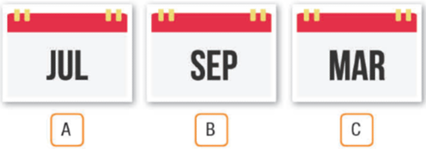
2. What have the pigs been eating?
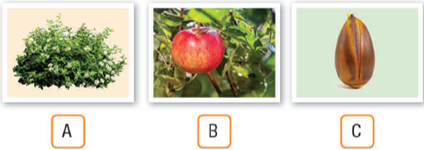
3. What did Lisa like most on her holiday?
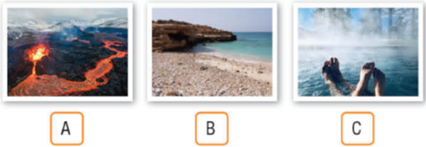
4. What type of species is Dr. Scott studying now?
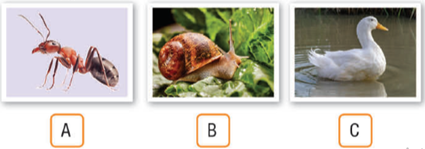
5. What will Lisa and Paul do their project on?
